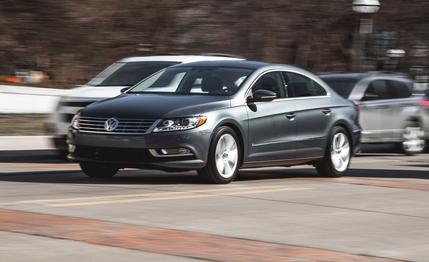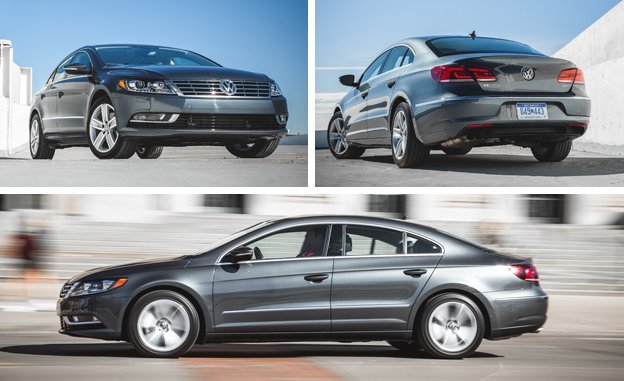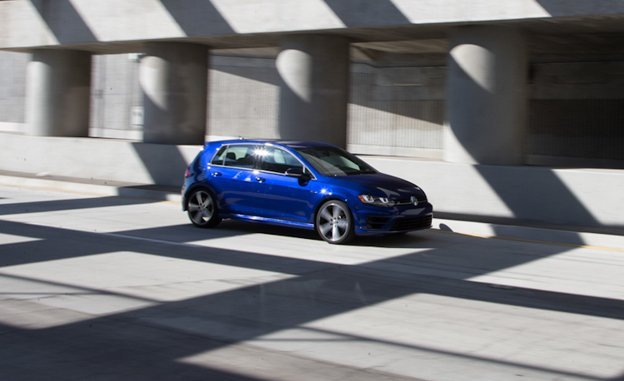
 Instrumented Test
Instrumented Test
Introduced for 2009, the Volkswagen CC is old enough now that we’re seeing its replacement in concept form at auto shows. That show car marks a revival of the “four-door coupe” pretense that the current marketing pretty much abandoned after 2013, which is when a third seatbelt was added to the rear bench and the styling was amended to share some cues with the U.S.-built Passat. The cars have different underpinnings, however, so the Passat name this car wore at its launch has been dropped—it’s now just the CC—and the VW marketeers tag it as “the mid-size sports sedan with shocking good looks” (emphasis ours).
While the exterior design perhaps isn’t so shocking anymore, it remains appealing, its crisp purity of line unsullied by the grille and lighting changes of a couple years ago. This German-built four-door “resembles” a Tennessee-built Passat in the same way that an Art Fitzpatrick advertising illustration of the late 1960s resembled the real Pontiacs they promoted—it’s lower with a more alluring stance and promises more excitement. The interior still looks handsome, and the controls are easy to locate and operate. We’ve never warmed to the metallic trim strip that spans the dashboard, and the control layout belies the car’s age, which some of us, frankly, find appealing in its relative simplicity when compared with the clutter of some more modern designs. The CC is also more engaging to drive than your standard family sedan, as you’d expect from a car with a base price fully 50 percent higher than that of the lowliest Passat.


A stripper Passat, though, is pared back to a store-brand frozen-fish-sticks price. The base CC as tested here is a different bowl of bouillabaisse, a driver’s delight that includes essential equipment but eschews unneeded distractions. Officially, it’s the Sport 2.0T with the standard six-speed manual transmission, and its $33,550 sticker reflects no options. The entry price has been a little lower in the past, but the packaging has been realigned and this year’s CC includes a standard 5.0-inch touch screen, navigation, a rearview camera, and adaptive bixenon headlights—it’s a better value proposition than was the 2013 we tested previously in a stick-versus-automatic comparison. This one ran near-identical numbers at the track, taking 6.5 seconds to hit 60 mph en route to a quarter-mile in 15.1 at 94 mph, stopping from 70 mph in 168 feet, and cornering at 0.86 g. That’s good enough to be entertaining on your favorite byways without setting anyone’s hair on fire.
It goes about its business with a really sweet balance of handling and ride comfort, good feedback and control in its pedals and shifter, and the responsive engine we’ve applauded in many VW products. We could wish for a bit more steering feel, but the CC was one of the earliest to get electric assist right, with proportional effort and predictable response. For those who value such automotive traits, the CC delivers, and the base model is probably the best way to appreciate them.
Another $1280 would put you into the R-Line variant with some minor cosmetic tweaks, but the only functional changes would be 18-inch wheels in place of the 17s on this car, as well as paddle shifters if you also opted for the DSG automatic. Our earlier test found the manual preferable, though, and its availability remains an asset. The top-spec Executive trim with this engine brings the DSG with paddles; a larger, 6.5-inch touch screen; keyless access; leather upholstery; and wood trim. Or you can go deep into the mid-$40K range by opting for the driveline upgrades of the 280-hp 3.6-liter VR6 engine, 4MOTION all-wheel drive, and Executive Lux trim that includes parking sensors, massaging seats, and more.


A 2.0T R-Line won a comparison test in 2010 against more powerful competition from Buick and Acura. Load it up with the six and 4MOTION, though, and a CC starts bumping heads with some pretty desirable and much fresher entry-luxury machines. Instead, consider the Sport 2.0T as a viable alternative to mid-size family sedans like the Honda Accord, Mazda 6, and its more utilitarian-minded Passat stablemate.
Consider: We recently tested a Mazda 6 that had a lot of modern safety and telematics features that this VW lacks, including a touch screen bigger than any you can get in the CC, and it was loaded to within $200 of this car’s MSRP. The 6 has a little more space for both passengers and cargo and achieves much better fuel economy according to the EPA. The Mazda is also pretty to look at and good to drive, although its track numbers were all a bit behind the CC’s (7.0 seconds to 60 mph, 175 feet to stop from 70 mph, 0.84 g). The case for the CC is that it’s quieter under hard acceleration, a bit more refined in both handling and ride, and, in this guise, has a manual. We’d not argue with anyone who decided the 10Best-winning Mazda was the better buy, but the CC still merits serious consideration.